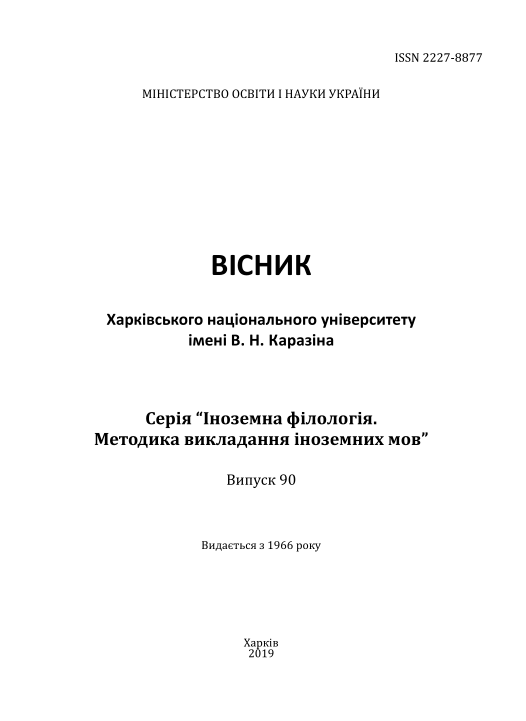Distinctive features of horizontal and vertical symbols in fairy tales and specificity of their reproduction in translation
Abstract
Orientation in space plays an essential role for a human being in the view of his / her life. Beginning from the ancient times, people explored space through horizontal and later vertical dimensions. This led to symbolization of objects that surrounded them. Complete reflection of symbols of space, in particular, horizontal and vertical symbols, is concisely traced in the fairy tale genre. Being one of the archaic forms of folklore, the fairy tale co-opted various elements of mythological beliefs of primitive people, their cognition and way of life, and later was supplemented by individual idiosyncratic elements of the world view. Symbols of both dimensions actualize primary (physical) and secondary meanings (which are also signified by evaluative, moral and ethical, as well as ecclesiastically religious meanings). The most frequently used vertical and horizontal symbols in the fairy tales are those actualized according to the “right” / “left” and “top” / “bottom” criteria. Despite relatively extended research in the field of fairy tale symbols, there are few studies which deal with the issue of conveying vertical and horizontal symbols into the target language. The aim of the article is to highlight the ways of rendering vertical and horizontal symbols taken from English and Ukrainian fairy tales, and to assess adequacy of their reproduction in the target language. According to the results of the research, it can be concluded that due to its universal character, the symbols of vertical and horizontal space are easily rendered into the receiving cultures. However, adequate reproduction of vertical and horizontal symbols requires identification of their role in a certain fairy tale text, and, consequently, the importance of their rendering into the target language.
Downloads
References
Amerykanski kazky / Lyman Frank Baum ; transl. by O. Nahrebetskyi : pic. K. Lavra. Kyiv : Znannya.
Angliyski narodni kazky [English folk tales] (1980) / transl. by O. Terekh. Kyiv: Veselka.
Vayld, O. (2018). Kentervilskiy Pryvyd [The Centerville Ghost] / transl. by D. O. Radiyenko. Kharkiv: Pholio.
Vayld, O. (2016). Khlopchyk-zirka ta inshi Kazky [The Star-boy and other fairy tales] / transl. by I. V. Korunets. Kyiv: Znannya.
Verkhoturova, N. A. (2013). Tekstoobrazuyuschaya funktsiaya simvola «Kolokol» v yevropeyskoy i americanskoy poesii XVIII-XIX v. v russkikh perevodakh [Text-forming function of the «Kolokol» symbol in the European and American poetry of the XVIII-XIX] centuries in Russian translations]. Vestnik Tomskoho hosudarstvennoho universiteta – Messenger of Tomsk State University, 372, 19–24 (in Russian).
Entsyklopedychniy slovnyk symvoliv kultury Ukraiiny [The Encyclopedia of the symbols of Ukraine] (2015) / ed. by V. P. Kotsur, O. I. Potapenko, V. V. Kuybidy. Korsun-Shevchenkivskiy: FOP Havryshenko V. M.
Kykot, V. M. (2013). Pidtekstovyi obraz, symvol ta pereklad [Sub-textual image, symbol and translation]. Filolohichni traktaty – Philological Tractates, 2 (5), 43–57 (in Ukrainian).
Losev, A. F. (1995). Problema simvola i realisticheskoye iskusstvo [The problem of symbol and realistic art]. Moskva: Iskusstvo. Available at: https://www.gumer.info/bibliotek_Buks/Culture/Los_PrSimv/index.php
Lotman, Yu. M. (2000). Semiosfera [Semisphere]. Sankt-Peterburh: Iskusstvo.
Novikova, M. O., and Shama, I. M. (1996). Simvolika v khudozhestvennom tekste. Simvoly prostranstva [Symbols of an artistic text. Symbols of space]. Zaporoshye: «Verzhe».
Panasenko, K. O. (2015). Symvolika poetychnoho tekstu yak obyekt perekladu. Avtoref. diss. kand. filol. nauk [The symbolism of poetic texts as an object of translation. Cand. philol. sci. diss. synopsis]. Kherson: Khersonkiy derzhavnyi universitet (in Ukrainian).
Pirs, Ch. (2000). Nachalo prahmatisma: tom 1 [The rise of pragmatism: vol. 1]. Moskva: Alteya.
Rebriy, O. V. (2012). Suchasni kontseptsiyi tvorchosti u perekladi. Monohrafiya [Modern concepts of creativity in translation. Monograph]. Kharkiv. nats. un-tu im.V.N. Karazina. – V.N. Karazin Kharkiv. National Univ. (in Ukrainian).
Sokolova, V. V. (2006). Kohnitivnyi aspekt predstavleniya simvola v parallelnykh poeticheskih tekstakh. Diss. kand. filol. nauk [The cognitive aspect of symbolic representation in parallel poetic texts. Cand. philol. sci. diss.]. Ufa: Bashkirskiy hosudarstvennyi universitet. 201 p. (in Russian).
Uayld, O. (2011). Zoryanyy khlopchyk [The Star Boy] / transl. by T. Nekryach. Kyiv: KM-BUKS. Available at: http://testlib.meta.ua/book/162013/
Ukrainski narodni kazky [The Ukrainian Folk Tales] (1996) / ed. by S. Khrustalyova. Kyiv: Irpin.
Florenskiy, P. (1999). Istoriya filosophiya: Zapad – Rossiya – Vostok [The history of philosophy: West – Russia – East]. Moskva: «Hrekolatinskiy kabinet» Yu. A. Shychalina.
Shelestyuk, Ye. V. (2004). O dialektike ustoychivosti i izmenchivosti kontsepta i simvola [As to the dialectics of variability / invariability of concept and symbol]. Yasyk. Kultura. Kommunikatsiya – The language, culture and communication. Chelyabinsk: URAO, 178–187.
Baum, L. (2017). American Fairy Tales. Kyiv: Znannya.
Campbell, J. (2004). The Hero with a Thousand Faces. Princeton: Princeton University Press.
Cirlot, J. E. (1990). Dictionary of symbols: 2nd ed. / transl. by J. Sage. London: Routledge.
Cooper, J. C. (1987). An Illustrated Encyclopaedia of Traditional Symbols. Thames & Hudson.
Da Silva, F. V. (2002). Metamorphosis: The Dynamics of Symbolism in European Fairy Tales. New York: Peter Lang.
How Ivan Went to See the Sun (1989) / transl. by A. Bilenko. Kiev: Dnipro Publishers.
Jacobs, J. (1890). English Fairy Tales. Pennsylvania: A Penn State Electronic Classics Series Publication. Available at: https://archive.org/details/englishfairytal00jacogoog/page/n46
Precious // Cambridge Dictionary. Available at: https://dictionary.cambridge.org/dictionary/english/precious
Ukrainian Folk Tales (1985) / ed. by I. Zheleznova. Kyiv: Dnipro Publishers.
Wilde, O. (1891). The House of Pomegranates. London: James R. Osgood McIlvaine & Co.,




